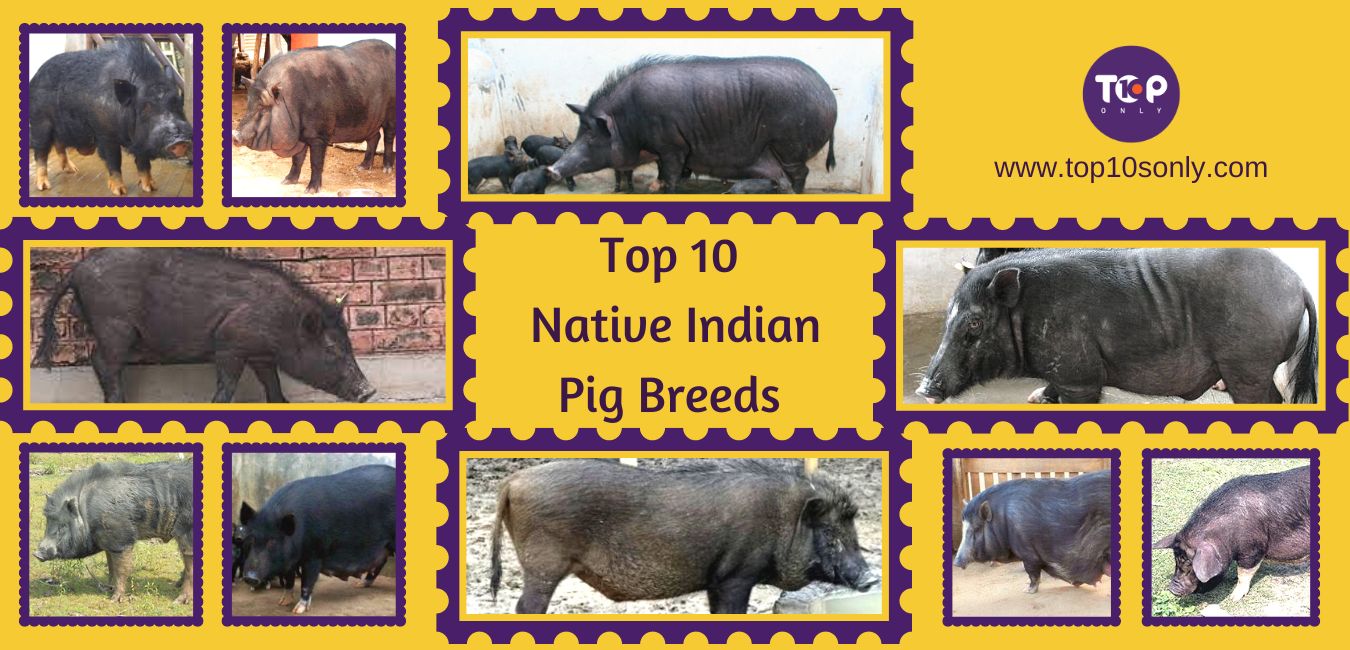Pig farming is one of the most lucrative livestock businesses, and many people, both in urban and rural areas, have successful pig-farming businesses. One of the major reasons for this business to thrive is that pigs are great breeders, can deliver more than 10 piglets in one birth, and can produce litters twice a year. They have the fastest growth rate compared to any other livestock in this category. Also, pig meat is popular not just in India but has great demand outside the country too. Pig meat is tasty and has a good amount of protein, so all-in-all, it is a popular business for its profitability. Read below to learn about the top 10 best native pig breeds.
List of Top 10 Best Native Pig Breeds
Many native and exotic pig breeds in India are prolific breeders and have a high feed conversion rate. They mature faster than other livestock and feed on many inedible foods. Plus, setting up pig farming is easy and requires very little investment in buying equipment or building houses. While there are many pig breeds found in India, not all are suitable for pig farming, so you should opt for the right breed of pig. Let us discuss the top 10 pig breeds in India:
1. Ghungroo
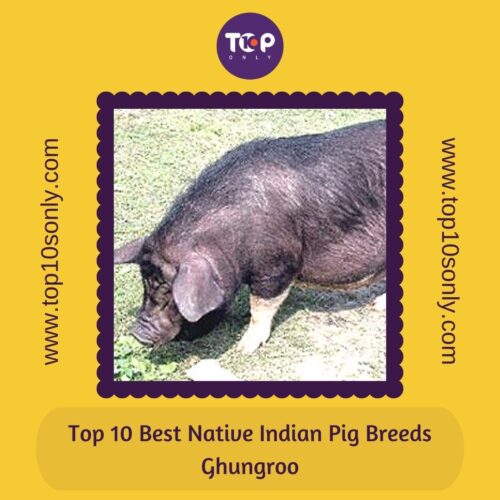
ghungroo
Ghungroo or Ghoongroo is one of the most popular of the top 10 indigenous pig breeds in India that are popular all over the country, apart from local people, as it is highly prolific. It is also well known for producing pork that is of high quality. It is also good at food conversion and can live on kitchen waste and agricultural products. They have high production efficiency, and both sexes are easy to handle as they are docile. The other characteristics of this pig breed are:
This Native Indian Pig Breed Is Also Known As
NA
Place Of Origin
North Bengal and the nearby districts of Assam
Body Weight
The adult pig weighs about 55 to 60 kg
Body Colour
Black
Physical Characteristics
These pigs have a bulldog look with folded skin on their necks and faces. They have ears that are heart-shaped and cylindrical and a long belly that is barrel-shaped. Typically, they have a long tail.
Climate Adaptation
They are adapted to the local coastal environment.
Gestation Period
112 to 115 days
Farrowing
An average of 210 days with 1 to 2 farrowings per year.
Age At First Farrowing
The female pigs reach sexual maturity at about 10 months, and the males at about 8 months.
Average Litter Size
They are highly prolific and give birth to 6 to 10 piglets.
Interesting Facts
They produce pork that is of high quality even after consuming kitchen waste and agricultural byproducts.
2. Niang Megha
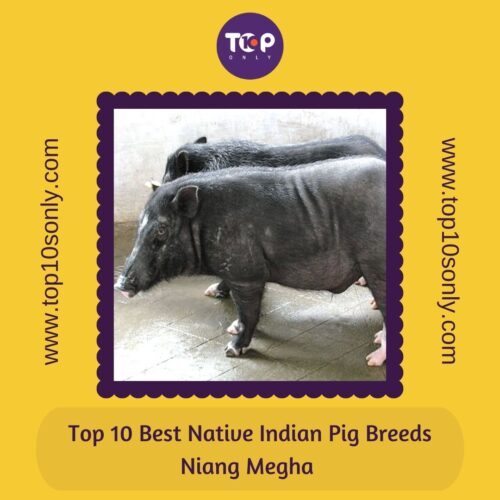
niang megha
Niang Megha is one of the oldest pig breeds and is at the top of the list of pig breeds in India. The name of the pig is derived from the tribe that dwells in that region. They have the typical looks that are associated with pigs and are hardy animals that can resist most types of diseases. Niang Megha pigs are highly prolific and have feeding habits that are adjustable. The other features of this pig list of pig breeds in India breed are:
This Native Indian Pig Breed Is Also Known As
Khasi local or Meghalaya Local
Place Of Origin
Khasi, Jaintia, and Garo hills of Meghalaya
Body Weight
The adult pig weighs about 50 to 60 kg
Body Colour
Black with the legs and forehead having white patches
Physical Characteristics
They are wild-looking pics with tapering and medium snout. They have long bristles on the midline, and the forehead has white patches. The ears are vertically extended and small but erect. There are white patches on the legs.
Climate Adaptation
They are adapted to the hilly regions of Meghalaya
Gestation Period
112 to 136 days
Farrowing
An average of 206 days with 1 to 2 farrowing per year.
Age At First Farrowing
The age at first farrowing is 347 days.
Average Litter Size
They are highly prolific and give birth to 6 piglets.
Interesting Facts
They are usually reared not just for their meat but also for their bristles.
3. Agonda Goan
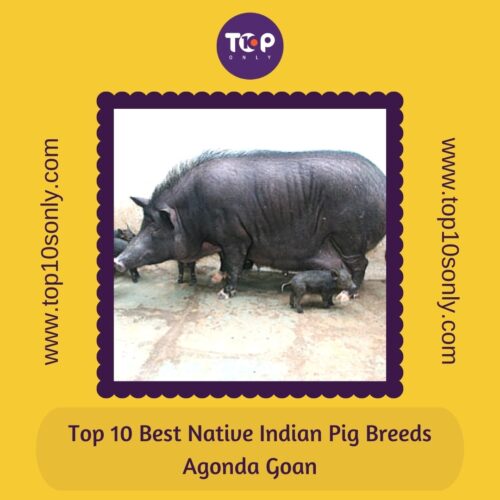
agonda goan
Agonda Goan is a popular breed of pig that is known for its profitability in rearing. These are one of the best breeds of pig in India because they offer meat that is highly palatable and lean. They have good mothering capabilities but are slow-growing. These are pigs that are hardy and sustainable in any scavenging place, but they are wild in nature. The other features of this pig breed are:
This Native Indian Pig Breed Is Also Known As
Gavathi Dukor or Village Pig
Place Of Origin
Agonda, Goa
Body Weight
The adult pig weighs about 40 kg
Body Colour
Mostly black, with legs and face having a few white patches. The bristles are grey in colour and rough.
Physical Characteristics
These pigs are of small to medium size when bred in scavenging conditions and can be large in size when maintained on pig farms. They are black in colour and commonly have faces with white markings. They have a short snout, erect ears, and legs with white markings.
Climate Adaptation
They are highly adaptable to hot and humid weather and are low-maintenance.
Gestation Period
112 to 136 days
Farrowing
An average of 195 days with 1 to 2 farrowings per year.
Age At First Farrowing
The age at first farrowing is 195 days.
Average Litter Size
They are slow growing and have an average litter size of 7
Interesting Facts
They are used for pork and sausage making, called ‘chouris’. The manure that is produced is used for gardening.
4. Tenyi Vo
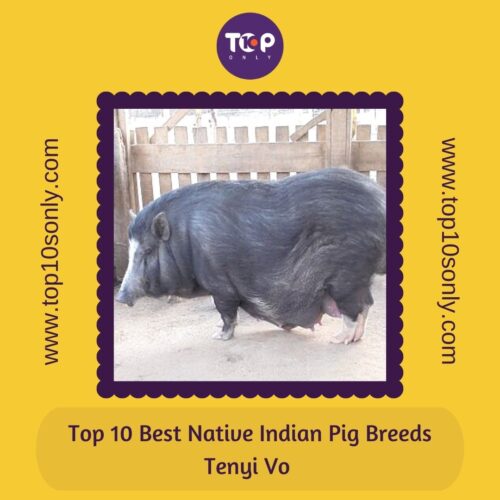
Tenyi Vo is an indigenous pig breed from the North East of India and has been registered by the ICAR (Indian Council of Agricultural Research) and NBAGR (National Bureau of Animal Genetic Resources). This breed was approved as one of the few breeds of livestock that were approved for registration. Here are the major characteristics of this registered pig breed in India:
This Native Indian Pig Breed Is Also Known As
Suho, Votho or Naga Local
Place Of Origin
Mostly found in the Tuensang, Angami, Mao, and Chakesang districts of Nagaland.
Body Weight
The adult pig weighs about 35 to 50 kg
Body Colour
Mostly black in colour.
Physical Characteristics
These pigs are small and hairy. They are mostly black and have white stripes on their shoulders and backs. They are spotted on the forehead with eyes that are alert and bright. They have elongated faces with small, erect ears. The snout is tapering, long, and strong. They are potbellied and have legs with white hooves. The tail is white and straight and touches the hock joint.
Climate Adaptation
They are highly adaptable to the local environment and survive without too much care
Gestation Period
109 to 116 days
Farrowing
An average of 180 days with 1 to 2 farrowings per year.
Age At First Farrowing
The age at first farrowing is 150 days.
Average Litter Size
They are slow growing and have an average litter size of 4 to 6
Interesting Facts
This pig’s meat has less fat and is very tender. It is flavoursome and has a unique taste.
5. Nicobari
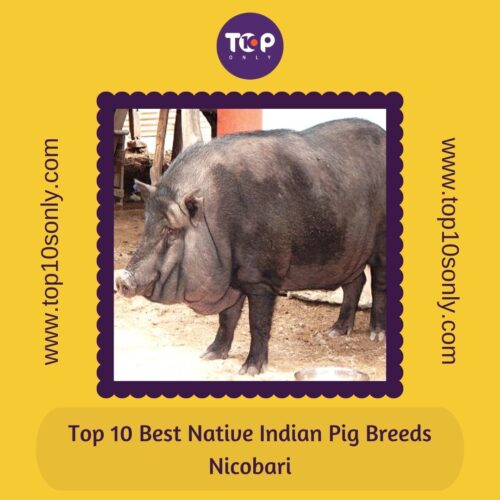
nicobari
The Nicobari pig is called the pride of Nicobar and is among the registered pig breeds of India. It is the best Indian pig breed that is linked very closely to the local tradition and culture of the Nicobarese tribe. These are semi-feral in nature and are not used by the tribal people for commercial purposes. Currently, these indigenous pigs need to be conserved as they face extinction. The features of this breed are:
This Native Indian Pig Breed Is Also Known As
Ha-Un
Place Of Origin
Andaman and Nicobar Group of Islands
Body Weight
The adult pig weighs about 40 to 50 kg
Body Colour
Brownish, grey, or black in colour
Physical Characteristics
This is a pig breed that is short-sized but sturdy. The back of the pig has a marked bristle crest that extends from the shoulder to the base of the tail. The face is concave to flat and has a short neck with a large jowl, which is a prominent feature of this breed. They have legs with hooves that are greyish-white.
Climate Adaptation
They are highly adaptable to the local environment and are sustainable with low care.
Gestation Period
112 to 115 days
Farrowing
The farrowing interval is 8 to 10 months.
Age At First Farrowing
The age at first farrowing is 11 months.
Average Litter Size
6 to 10
Interesting Facts
These pigs are reared by the local tribes for their meat and feed on fish waste, coconut, and crabs.
6. Doom
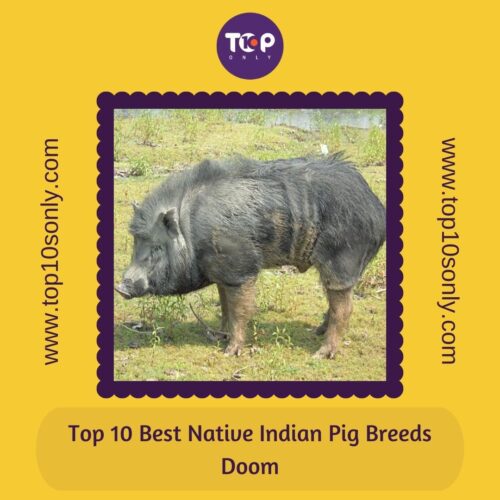
doom
The Doom Pig is a breed that is the only registered breed in Assam. This pig is popular locally for its bristles and is one of the top 10 pig breeds for meat. These are hardy animals that adapt well to any type of condition and need very menial feed. They have good reproductive capacity as well as carcass yield, but due to cross-breeding, this native breed is on the decline. The features of this pig breed are as below:
This Native Indian Pig Breed Is Also Known As
NA
Place Of Origin
Assam is the native tract of this pig breed. They are mainly found in the Boangaigaon, Goalpara, and Dhubri districts of Assam.
Body Weight
The adult pig weighs about 36 to 50 kg
Body Colour
They are black in colour
Physical Characteristics
This is a pig breed that is comparatively larger than the other local Assamese breeds. They have a thick bristle of hair that starts from the neck and goes up to the lumbar area. They have a face with a concave and short snout. They have short, erect ears and a flat belly.
Climate Adaptation
They are adapted to a migratory scavenging system, which is a special management system, and need minimal feed.
Gestation Period
112 days
Farrowing
The farrowing interval is 213 days.
Age At First Farrowing
The age at first farrowing is 368 days.
Average Litter Size
6
Interesting Facts
The meat obtained from this pig is considered highly palatable, is a lean meat variety, and is hence is costlier compared to other pig meat.
7. Zovawk
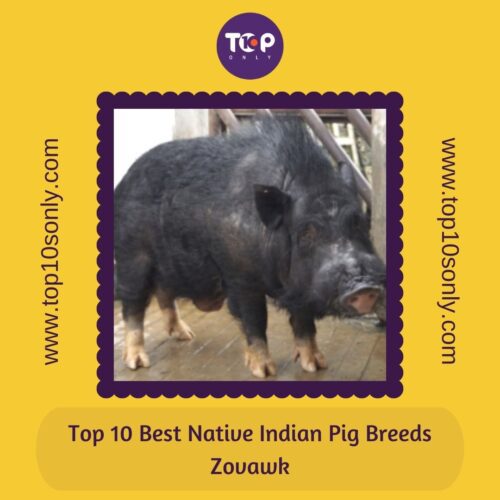
zovawk
The Zovawk pig breed is one of the local pigs that are available in the northeast part of the country. These pigs are of the scavenging type, and the pork derived from it is one of the most preferred meat options by the locals. These are hardy animals that are highly resistant to diseases and survive in the remotest areas. The other features of this pig breed are:
This Native Indian Pig Breed Is Also Known As
Mizo Local
Place Of Origin
It is predominantly found in the Siha, Mamit, Kolasib, Lunglei, Aizawal, and Champai districts of Mizoram.
Body Weight
The adult pig weighs about 54 to 59 kg
Body Colour
They are black in colour
Physical Characteristics
These are small-sized animals that are black in colour. They have white patches on their stomachs, and their foreheads have white with black spots. They have long bristles that are on the midline. They have erect ears and a concave snout. One of the main characteristics of this breed is the back has a concave top line with a pot belly.
Climate Adaptation
They are well suited to the hilly areas of the native tract.
Gestation Period
115 days
Farrowing
The farrowing interval is 315 days.
Age At First Farrowing
The age at first farrowing is 9 to 10 months.
Average Litter Size
5 to 8 piglets
Interesting Facts
The meat is known for its medicinal properties. It is mainly used for its pork and manure.
8. Ghurrah
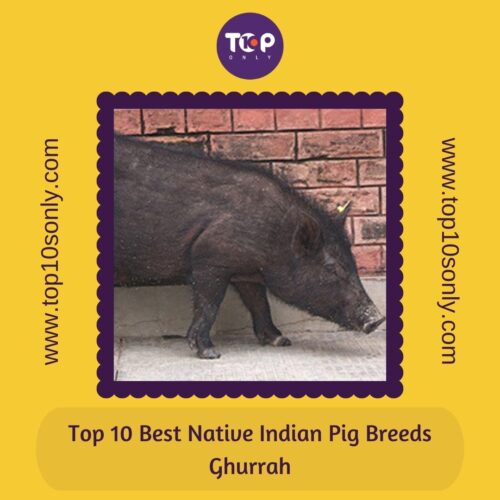
ghurrah
The Gurrah pig is another of the registered breeds of pigs in India and is found in various parts of Uttar Pradesh. These are pigs that are well-suited to the local conditions and are mainly used for their meat and manure. Their bristles are also sometimes used for making art or paintbrushes. The major features of this pig breed are as below:
This Native Indian Pig Breed Is Also Known As
Bareilly local, Deshi
Place Of Origin
They are native to the Bareilly district of Uttar Pradesh. It is also found in Sitapu, Pilibhit, Budaun, and Shahjahanpur districts of Uttar Pradesh.
Body Weight
The adult pig weighs about 46 to 48 kg
Body Colour
Mostly black, but there are a few that are brownish or greyish-black.
Physical Characteristics
These are medium-sized animals with angular bodies, a long, straight snout, and a flat belly. There are thick bristles that start at the neck and extend to the shoulders. The face is triangular, and the head is elongated. They have ears that are lead-shaped, and the legs are white below the hock joint.
Climate Adaptation
They are well suited to the local conditions.
Gestation Period
NA
Farrowing
NA
Age At First Farrowing
NA.
Average Litter Size
6 piglets
Interesting Facts
They make a peculiar sound called “ghur” and are hence called Ghurrah.
9. Mali
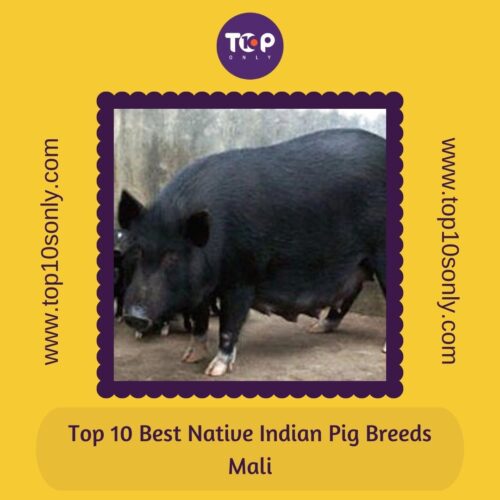
mali
This is an indigenous pig that is a compact-sized animal and is one of the best pig breeds in India. These pigs are aggressive, and females show nesting and mothering abilities. Since males are aggressive, they are usually not kept in the same pen. Some of the features of this breed are:
This Native Indian Pig Breed Is Also Known As
Tripura Desi
Place Of Origin
They are native to the Tripura district
Body Weight
The adult pig weighs about 68 to 71 kg
Body Colour
Mostly black in colour.
Physical Characteristics
They are a compact, medium-sized pig breed with a pot belly. They have small to medium bristles that are spread throughout the body. They have erect ears that are perpendicular to the body and a concave snout. They have short legs and long tails.
Climate Adaptation
They are well suited to the local conditions.
Gestation Period
115 days
Farrowing
The farrowing interval is 178 days
Age At First Farrowing
The average age at first farrowing is 281 days.
Average Litter Size
8 to 12 with 12 piglets being uncommon.
Interesting Facts
They are the preferred pigs for slaughtering during rituals.
10. Purnea
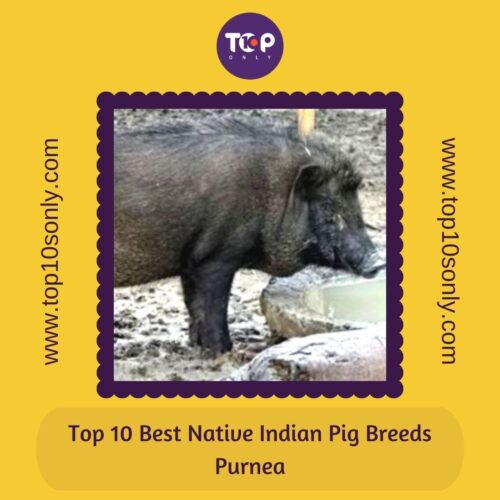
purnea
Jharkhand has the second-largest pig population after Assam, which is leading the top 10 pig-producing states in India. This is one of the first breeds to be registered in Jharkhand. These medium-sized animals are used for their pork and manure. The main features of this pig breed are:
This Native Indian Pig Breed Is Also Known As
Vanachal Black
Place Of Origin
Sahibganj district of Uttar Pradesh and Urnia and Katihar districts of Bihar.
Body Weight
The adult pig weighs about 41 to 50 kg
Body Colour
Mostly black in colour. Some animals have white spots on their lower limbs.
Physical Characteristics
They have compact bodies with a pot belly. They have thick bristles from the neck to the shoulders, and that gives them a wild look. They have a round face with erect and conical ears. The snout is concave and thick.
Climate Adaptation
They are well suited to the local conditions.
Gestation Period
114 days
Farrowing
The farrowing interval is 158 days and can furrow twice a year
Age At First Farrowing
The average age at first farrowing is 8 to 9 months.
Average Litter Size
4 to 6.
Interesting Facts
They are one of the most ferocious pigs in India.
Conclusion
Pigs have been an integral part of the food supply for humans for many years. While these animals were not particularly raised for their meat in India, it has since become a popular meat and is a delicious addition to a meal. Many people also keep pigs as pets for breed preservation, and they are suitable for organic gardening as they produce nutrient-rich waste.
If you are interested in learning more about indigenous breeds of animals in India, check out our Top 10 Native Indian Dog Breeds article that lists some of the most popular Indian breeds of dogs!
Frequently Asked Questions About Native Indian Pig Breeds
1. What are the Indian native pig breeds?
India is home to several native pig breeds that have evolved over centuries to suit the local climate, feed availability, and cultural practices. Some of the prominent native pig breeds in India include Purnea, Mali, Zovawk, Nicobari, Ghurrah, etc. Find out more details about these and other native Indian pig breeds from the article on this page.
2. Which pig is best for meat in India?
In India, several pig breeds are considered to be the best for meat production. The popular Indian pig breeds reared for high-quality pork/meat are Ghungroo, Tenyi Vo, Doom, etc. These breeds have been widely used in commercial pig farming due to their high growth rate, good feed conversion efficiency, and high-quality meat characteristics.
3. How many registered breeds of pigs are there in India?
There are currently 10 registered breeds of native pigs in India. Ghurrah, Mali, Nicobari, Tenyi Vo, Agonda Goan, Purnea, Niang Megha, Zovawk, Doom, and Ghungroo are the Indian registered pig breeds.

